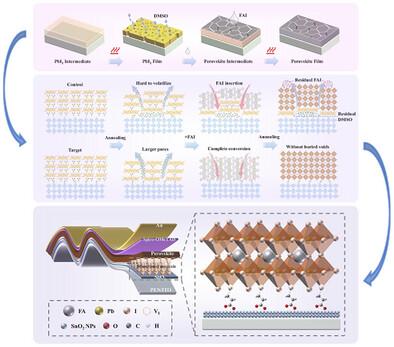Revealing Bifunctional Molecules Induced Adequate DMSO Extraction in Sequential Crystallization toward Efficient and Robust Flexible Perovskite Solar Cells
IF 19
1区 材料科学
Q1 CHEMISTRY, MULTIDISCIPLINARY
引用次数: 0
Abstract
Flexible perovskite solar cells possess great application potential in both stationary and mobile photovoltaics because of their lightweight and bendable features. However, the poor crystallinity of perovskite and the fragility of the buried interface on flexible substrates with a rough surface and poor wettability result in efficiency and durability losses. Herein, the critical role of buried interface quality in governing dimethyl sulfoxide (DMSO) evaporation and the sequential crystallization kinetics is uncovered. A facile and effective strategy is implemented by adopting several bifunctional polar molecules with different groups, including 3-aminopropanoic acid (APAC), 3-iodo-1-propanol (IDPA), and 3-iodopropionic acid (IDPAC), to modify the SnO2/perovskite interface. Multifunctional molecules bearing appropriate functional groups can concurrently passivate interfacial defects on both sides, which strongly adsorb DMSO molecules, enabling adequate solvent removal during crystallization and minimizing buried interfacial voids. This dual-passivation strategy simultaneously yields stress-relaxed flexible perovskite films while strengthening interfacial adhesion and charge transport properties. Consequently, IDPAC-modified rigid cells achieve a champion efficiency up to 25.59% (certified 24.92%), while flexible devices exhibit a seductive efficiency of 24.90% (certified 24.39%) and retain 92% of the initial efficiency after bending 10 000 cycles with a radius of 5 mm.

揭示双功能分子诱导DMSO在序晶化过程中充分萃取,以制备高效、坚固的柔性钙钛矿太阳能电池
柔性钙钛矿太阳能电池由于其轻量化和可弯曲的特点,在固定式和移动式光伏发电中都具有很大的应用潜力。然而,由于钙钛矿结晶度差,以及在表面粗糙、润湿性差的柔性衬底上埋藏界面的脆弱性,导致效率和耐用性损失。本文揭示了埋藏界面质量在控制二甲亚砜(DMSO)蒸发和顺序结晶动力学中的关键作用。采用3-氨基丙酸(APAC)、3-碘-1-丙醇(IDPA)和3-碘-丙酸(IDPAC)等具有不同基团的双功能极性分子来修饰SnO2/钙钛矿界面,实现了一种简单有效的策略。带有适当官能团的多功能分子可以同时钝化两侧的界面缺陷,从而强烈吸附DMSO分子,从而在结晶过程中充分去除溶剂,并最大限度地减少隐藏的界面空隙。这种双钝化策略同时产生应力松弛的柔性钙钛矿薄膜,同时增强界面附着力和电荷输运性能。因此,idpac修饰的刚性电池的效率高达25.59%(认证24.92%),而柔性器件的效率为24.90%(认证24.39%),并且在半径为5毫米的弯曲10,000次后保持92%的初始效率。
本文章由计算机程序翻译,如有差异,请以英文原文为准。
求助全文
约1分钟内获得全文
求助全文
来源期刊

Advanced Functional Materials
工程技术-材料科学:综合
CiteScore
29.50
自引率
4.20%
发文量
2086
审稿时长
2.1 months
期刊介绍:
Firmly established as a top-tier materials science journal, Advanced Functional Materials reports breakthrough research in all aspects of materials science, including nanotechnology, chemistry, physics, and biology every week.
Advanced Functional Materials is known for its rapid and fair peer review, quality content, and high impact, making it the first choice of the international materials science community.
 求助内容:
求助内容: 应助结果提醒方式:
应助结果提醒方式:


